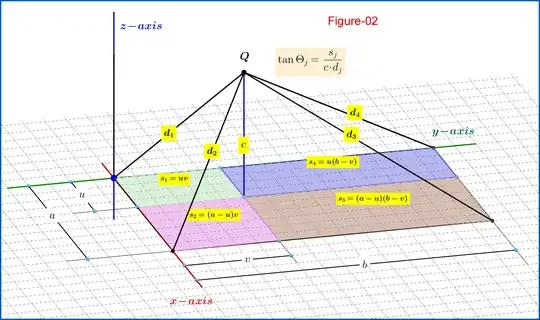Note : Although late in the party, I think that there is no need of an other answer to this question, because of the excellent and complete Emilio Pisanty's answer (with all the nuts and bolts in detail). But it is the timing that a few days ago I tried to find a formula for the flux of the electric field intensity $\,\mathbf{E}\,$ of a point charge $\,Q\,$ through a rectangular parallelogram as in Figure-01.

My effort ended up to a result I am posting here as Proposition-Practical Rule :
Proposition-Practical Rule :
Let a rectangular parallelogram with sides $\,a,b\,$ and a point $\,Q\,$ positioned at a height $\,c\,$ vertically up of one of its corners, see Figure-01. Then the solid angle $\,\Theta\,$ by which the point $\,Q\,$ "sees" the rectangular parallelogram is determined by the equation
\begin{equation}
\tan\Theta=\dfrac{s}{c\!\cdot\!d}=\dfrac{a\!\cdot\!b}{c\!\cdot\!\sqrt{a^{2}+b^{2}+c^{2}}}
\tag{01}
\end{equation}
where $\,s=a\!\cdot\!b\,$ the area of the rectangular parallelogram and $\,d=\sqrt{a^{2}+b^{2}+c^{2}}\,$ the diagonal from $\,Q\,$ to the opposite corner.
Equation (01) is proved in section Differential Geometry(1) for completness although its proof is hidden in Emilio Pisanty's answer.
Now, note that if $\,Q\,$ is a point charge in empty space then the flux through the parallelogram is
\begin{equation}
\Phi=\dfrac{\Theta}{4\pi}\dfrac{Q}{\epsilon_{0}}
\tag{02}
\end{equation}
As an example, if we have a cube of side $\,L=a=b=c\,$ then for the flux through one of its faces from a point charge $\,Q\,$ positioned on one of the opposite corners
\begin{equation}
\tan\Theta=\dfrac{L^{2}}{\sqrt{3}L^{2}}=\dfrac{1}{\sqrt{3}} \Longrightarrow \Theta =\dfrac{\pi}{6}
\tag{03}
\end{equation}
so
\begin{equation}
\Phi=\dfrac{\dfrac{\pi}{6}}{4\pi}\dfrac{Q}{\epsilon_{0}}=\dfrac{1}{24}\dfrac{Q}{\epsilon_{0}}
\tag{04}
\end{equation}
in agreement to the answers given therein : Flux through side of a cube, and especially the excellent joshphysics's answer using the symmetry properties of the configuration.

If the point charge $\,Q\,$ is positioned at a height $\,c\,$ vertically up of a point inside the parallelogram as in Figure-02 then according to equations (01) and (02) :
\begin{align}
\Phi & = \left(\dfrac{\Theta_{1}\!+\!\Theta_{2}\!+\!\Theta_{3}\!+\!\Theta_{4}}{4\pi}\right)\dfrac{Q}{\epsilon_{0}}\:, \quad \text{where}
\tag{05}\\
\Theta_{1} & = \arctan\left(\dfrac{s_{1}}{c\!\cdot\!d_{1}}\right) =\arctan\left[\dfrac{uv}{c\sqrt{u^{2}\!+\!v^{2}\!+\!c^{2}}}\right]
\tag{06.1}\\
\Theta_{2} & = \arctan\left(\dfrac{s_{2}}{c\!\cdot\!d_{2}}\right) =\arctan\left[\dfrac{(a\!-\!u)v}{c\sqrt{(a\!-\!u)^{2}\!+\!v^{2}\!+\!c^{2}}}\right]
\tag{06.2}\\
\Theta_{3} & = \arctan\left(\dfrac{s_{3}}{c\!\cdot\!d_{3}}\right) = \arctan\left[\dfrac{(a\!-\!u)(b\!-\!v)}{c\sqrt{(a\!-\!u)^{2}\!+\!(b\!-\!v)^{2}\!+\!c^{2}}}\right]
\tag{06.3}\\
\Theta_{4} & = \arctan\left(\dfrac{s_{4}}{c\!\cdot\!d_{4}}\right) = \arctan\left[\dfrac{u(b\!-\!v)}{c\sqrt{u^{2}\!+\!(b\!-\!v)^{2}\!+\!c^{2}}}\right]
\tag{06.4}
\end{align}
For the question : if in equations (06) we set $\,a=b=L\,$ and $\,u=v=c=\delta\,$ then
\begin{align}
\Theta_{1} & = \arctan\left(\dfrac{s_{1}}{c\!\cdot\!d_{1}}\right) =\arctan\left[\dfrac{\delta^{2}}{\delta^{2}\sqrt{3}}\right]=\arctan\left(\dfrac{1}{\sqrt{3}}\right)=\dfrac{\pi}{6}
\tag{07.1}\\
\Theta_{2} & = \arctan\left(\dfrac{s_{2}}{c\!\cdot\!d_{2}}\right) =\arctan\left[\dfrac{(L\!-\!\delta)\delta}{\delta \sqrt{(L\!-\!\delta)^{2}\!+\!\delta^{2}\!+\!\delta^{2}}}\right]=\arctan\left[\dfrac{(L\!-\!\delta)}{ \sqrt{(L\!-\!\delta)^{2}\!+\!2\delta^{2}}}\right]
\tag{07.2}\\
\Theta_{3} & = \arctan\left(\dfrac{s_{3}}{c\!\cdot\!d_{3}}\right) = \arctan\left[\dfrac{(L\!-\!\delta)^{2}}{\delta\sqrt{2(L\!-\!\delta)^{2}\!+\!\delta^{2}}}\right]
\tag{07.3}\\
\Theta_{4} & = \arctan\left(\dfrac{s_{4}}{c\!\cdot\!d_{4}}\right) = \arctan\left[\dfrac{\delta (L\!-\!\delta)}{\delta\sqrt{\delta^{2}\!+\!(L\!-\!\delta)^{2}\!+\!\delta^{2}}}\right]=\arctan\left[\dfrac{(L\!-\!\delta)}{ \sqrt{(L\!-\!\delta)^{2}\!+\!2\delta^{2}}}\right]
\tag{07.4}
\end{align}
so
\begin{align}
\lim_{L\rightarrow \infty}\Theta_{1} & \! = \lim_{\delta\rightarrow 0}\Theta_{1} =\lim_{\delta/L \rightarrow 0}\Theta_{1} =\arctan\left(\!\dfrac{1}{\sqrt{3}}\!\right)\!=\dfrac{\pi}{6}
\tag{08.1}\\
\lim_{L\rightarrow \infty}\Theta_{2} & = \lim_{\delta\rightarrow 0}\Theta_{2} =\lim_{\delta/L \rightarrow 0}\Theta_{2} =\arctan\left(+\;1\;\right)=\dfrac{\pi}{4}
\tag{08.2}\\
\lim_{L\rightarrow \infty}\Theta_{3} & = \lim_{\delta\rightarrow 0}\Theta_{3} =\lim_{\delta/L \rightarrow 0}\Theta_{3} =\arctan\left(+\infty\right)=\dfrac{\pi}{2}
\tag{08.3}\\
\lim_{L\rightarrow \infty}\Theta_{4} & =\lim_{\delta\rightarrow 0}\Theta_{4} =\lim_{\delta/L \rightarrow 0}\Theta_{4} = \arctan\left(+\;1\;\right)=\dfrac{\pi}{4}
\tag{08.4}
\end{align}
and from (05)
\begin{equation}
\Phi =\left(\dfrac{\Theta_{1}\!+\!\Theta_{2}\!+\!\Theta_{3}\!+\!\Theta_{4}}{4\pi}\right)\dfrac{Q}{\epsilon_{0}}=\left(\dfrac{\dfrac{\pi}{6}\!+\!\dfrac{\pi}{4}\!+\!\dfrac{\pi}{2}\!+\!\dfrac{\pi}{4}}{4\pi}\right)\dfrac{Q}{\epsilon_{0}}=\dfrac{7}{24}\dfrac{Q}{\epsilon_{0}}
\tag{09}
\end{equation}
(1) Differential Geometry

In order to find the flux $\,\Phi\,$ by equation (02) it's necessary to have the solid angle $\,\Theta\,$, that is the solid angle by which the point source $\,Q\,$ "sees" the rectangular parallelogram $\,\rm{ADBC}\,$, see Figure-03. This solid angle is by its definition
\begin{equation}
\Theta \stackrel{def}{\equiv}\dfrac{\mathrm{S}}{R^{2}}
\tag{dg-01}
\end{equation}
where $\,\mathrm{S}\,$ the area of a spherical patch, the (stereographic) projection of the parallelogram $\,\rm{ADBC}\,$ on the spherical surface of radius $\,R\,$ as in Figure.
The parametric equation of this spherical patch is
\begin{equation}
\mathbf{f}\left(x,y\right)=\dfrac{R}{\sqrt{x^{2}+y^{2}+R^{2}}}
\begin{bmatrix}
x \vphantom{\dfrac12}\\
y \vphantom{\dfrac12}\\
\sqrt{x^{2}+y^{2}+R^{2}}\!-\!R \vphantom{\dfrac12}
\end{bmatrix}\,, \quad x \in \left[0,a\right]\, \land y \in \left[0,b\right]
\tag{dg-02}
\end{equation}
Note that the parameters of this equation are the Cartesian coordinates $\,x,y\,$. The vector $\,\mathbf{f}\left(x,y\right)\,$ is the position vector of the (stereographic) projection on sphere of the point $\,(x,y)\,$ inside the parallelogram.
To find the area of the spherical patch $\,\mathrm{S}\,$ we use the vectors $\,\mathbf{f}_{x} ,\mathbf{f}_{y}\,$ tangent to the x-parametric and y-parametric curves
\begin{align}
\mathbf{f}_{x} & \equiv \dfrac{\partial\mathbf{f}\left(x,y\right)}{\partial x}=\dfrac{R}{\left(x^{2}+y^{2}+R^{2}\right)^{\frac32}}
\begin{bmatrix}
y^{2}+R^{2}\vphantom{\dfrac12}\\
-y\,x\vphantom{\dfrac12}\\
\hphantom{-}R\,x\vphantom{\dfrac12}
\end{bmatrix}
\tag{dg-03a}\\
\mathbf{f}_{y} & \equiv \dfrac{\partial\mathbf{f}\left(x,y\right)}{\partial y}=\dfrac{R}{\left(x^{2}+y^{2}+R^{2}\right)^{\frac32}}
\begin{bmatrix}
-x\, y\vphantom{\dfrac12}\\
x^{2}+R^{2} \vphantom{\dfrac12}\\
\hphantom{-}R\,y\vphantom{\dfrac12}
\end{bmatrix}
\tag{dg-03b}
\end{align}
from which for the infinitesimal normal to the surface we have
\begin{equation}
\mathrm{d}\mathbf{S} =\left(\mathbf{f}_{x}\boldsymbol{\times}\mathbf{f}_{y}\right)\mathrm{d}x\,\mathrm{d}y=
\dfrac{R^{2}}{\left(x^{2}+y^{2}+R^{2}\right)^{3}}
\begin{vmatrix}
\hphantom{-}\mathbf{i} & \hphantom{-}\mathbf{j} & \hphantom{-}\mathbf{k} \hphantom{-}\vphantom{\dfrac12}\\
\hphantom{-} y^{2}+R^{2} & -y\, x & R\,x \vphantom{\dfrac12}\\
-x\, y & \hphantom{-} x^{2}+R^{2} & R\,y \vphantom{\dfrac12}
\end{vmatrix}
\mathrm{d}x\,\mathrm{d}y
\tag{dg-04}
\end{equation}
that is
\begin{equation}
\mathrm{d}\mathbf{S} =\dfrac{R^{3}}{\left(x^{2}+y^{2}+R^{2}\right)^{2}}
\begin{bmatrix}
-x \vphantom{\dfrac12}\\
-y \vphantom{\dfrac12}\\
\hphantom{-}R\vphantom{\dfrac12}
\end{bmatrix}
\mathrm{d}x\,\mathrm{d}y
\tag{dg-05}
\end{equation}
while for the infinitesimal area
\begin{equation}
\mathrm{d}\mathrm{S} =\Vert\mathbf{f}_{x}\boldsymbol{\times}\mathbf{f}_{y}\Vert\mathrm{d}x\,\mathrm{d}y=\dfrac{R^{3}}{\left(x^{2}+y^{2}+R^{2}\right)^{\frac32}}\mathrm{d}x\,\mathrm{d}y
\tag{dg-06}
\end{equation}
So the area of the spherical patch $\,\mathrm{S}\,$ is
\begin{equation}
\mathrm{S} =R^{3}\int\limits_{y=0}^{y=b}\int\limits_{x=0}^{x=a}\dfrac{1}{\bigl(x^{2}\!+\!y^{2}\!+\!R^{2}\bigr)^{\frac32}}\mathrm{d}x \mathrm{d}y
\tag{dg-07}
\end{equation}
It's not accidental that this double integral appears in Emilio Pisanty's answer and although integrated therein we proceed also herein for completeness as follows :
From the indefinite integral
\begin{equation}
\int\dfrac{1}{\bigl(x^{2}\!+\!y^{2}\!+\!R^{2}\bigr)^{\frac32}}\mathrm{d}x =\dfrac{x}{\left(y^{2}\!+\!R^{2}\right)\sqrt{y^{2}\!+\!x^{2}\!+\!R^{2}}}+\text{constant}
\tag{dg-08}
\end{equation}
we have at first
\begin{equation}
\int\limits_{x=0}^{x=a}\dfrac{1}{\bigl(x^{2}\!+\!y^{2}\!+\!R^{2}\bigr)^{\frac32}}\mathrm{d}x =\dfrac{a}{\left(y^{2}\!+\!R^{2}\right)\sqrt{y^{2}\!+\!a^{2}\!+\!R^{2}}}
\tag{dg-09}
\end{equation}
so
\begin{equation}
\mathrm{S} =R^{3}\int\limits_{y=0}^{y=b}\dfrac{a}{\left(y^{2}\!+\!R^{2}\right)\sqrt{y^{2}\!+\!a^{2}\!+\!R^{2}}} \mathrm{d}y
\tag{dg-10}
\end{equation}
and after that from the indefinite integral
\begin{equation}
\int \dfrac{a}{\left(y^{2}\!+\!R^{2}\right)\sqrt{y^{2}\!+\!a^{2}\!+\!R^{2}}} \mathrm{d}y=\dfrac{\arctan\left(\dfrac{a y}{R\sqrt{y^{2}\!+\!a^{2}\!+\!R^{2}}}\right)}{R}+\text{constant}
\tag{dg-11}
\end{equation}
we have finally
\begin{equation}
\mathrm{S} =R^{2}\arctan\left(\dfrac{a\,b}{R\sqrt{a^{2}\!+\!b^{2}\!+\!R^{2}}}\right)=R^{2}\arctan\left(\dfrac{a\,b}{R\, d}\right)
\tag{dg-12}
\end{equation}
and so
\begin{equation}
\Theta =\dfrac{\mathrm{S}}{R^{2}}=\arctan\left(\dfrac{a\,b}{R\sqrt{a^{2}\!+\!b^{2}\!+\!R^{2}}}\right)=\arctan\left(\dfrac{a\,b}{R\, d}\right)
\tag{dg-13}
\end{equation}
proving equation (01).
Two 3D versions of Figure-03 are given below













